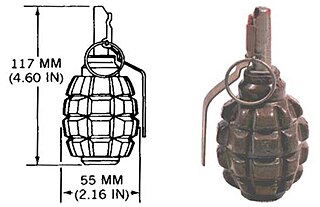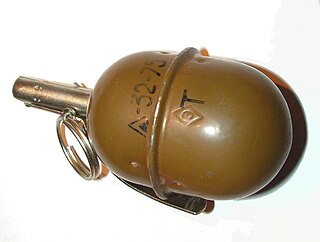RG, Rg or rg may refer to:

The M203 is a single-shot 40 mm under-barrel grenade launcher designed to attach to a rifle. It uses the same rounds as the older stand-alone M79 break-action grenade launcher, which utilizes the high-low propulsion system to keep recoil forces low. While compatible with many weapons, the M203 was originally designed and produced by the United States military for the M16 rifle and its carbine variant, the M4. The launcher can also be mounted onto a C7, a Canadian version of the M16 rifle; this requires the prior removal of the bottom handguard.

The Mk 19 grenade launcher is an American 40 mm belt-fed automatic grenade launcher that was first developed during the Vietnam War.

The M79 grenade launcher is a single-shot, shoulder-fired, break-action grenade launcher that fires a 40×46mm grenade, which uses what the US Army calls the High-Low Propulsion System to keep recoil forces low, and first appeared during the Vietnam War. Its distinctive report has earned it colorful nicknames, such as "Thumper", "Thump-Gun", "Bloop Tube", "Big Ed", "Elephant Gun", and "Blooper" among American soldiers as well as "Can Cannon" in reference to the grenade size; Australian units referred to it as the "Wombat Gun". The M79 can fire a wide variety of 40 mm rounds, including explosive, anti-personnel, smoke, buckshot, flechette, and illumination. While largely replaced by the M203, the M79 has remained in service in many units worldwide in niche roles.

The KS-23 is a Soviet shotgun. Because it uses a rifled barrel, it is officially designated by the Russian military as a carbine. KS stands for Karabin Spetsialniy, "Special Carbine". It is renowned for its large caliber, firing a 23 mm shotgun shell, equating to 6.278 gauge using the British and American standards of shotgun gauges and approximately 4 gauge using the current European standards, making it the largest-bore shotgun in modern use.

The GP-25 Kostyor ("Bonfire"), GP-30 Obuvka ("Shoe") and GP-34 are a family of Russian 40 mm under-barrel muzzleloaded grenade launchers for the AK family of assault rifles. They were first seen by the West in 1984, during the Soviet Invasion of Afghanistan. The GP-30 was lightened and the redesigned sighting system was moved to the right.

The Soviet F-1 hand grenade, is an anti-personnel fragmentation defensive grenade. It is based on the French F1 grenade and contains a 60 g (2.1 oz) explosive charge (TNT). The total weight of the grenade with the fuze is about 600 g (21 oz).

The RGD-5 is a post–World War II Soviet anti-personnel fragmentation grenade, designed in the early 1950s. The RGD-5 was accepted into service with the Soviet Army in 1954. It was widely exported, and is still in service with many armies in the Middle East and the former Soviet bloc.

The Soviet RG-42 was a fragmentation grenade designed by S.G. Korshunov.

RKG-3 is a series of Soviet anti-tank hand grenades. It superseded the RPG-43, RPG-40 and RPG-6 series, entering service in 1950. It was widely used in the 1973 Arab–Israeli War and remained a common weapon into the 2000s and early 2010s, being favoured by Iraqi insurgents during the American-led occupation. Modified versions of the RKG-3 series have also emerged in the Russian invasion of Ukraine.

The M67 grenade is a fragmentation hand grenade used by the United States military. The M67 is a further development of the M33 grenade, itself a replacement for the M26-series grenades used during the Korean and Vietnam Wars, and the older Mk 2 "pineapple" grenade used since World War I.

The RGO hand grenade is a defensive Soviet fragmentation hand grenade. It consists of a double layered steel pre-fragmented body. It is very similar to the single-layered offensive aluminium-bodied RGN hand grenade. It uses the UDZS dual action fuze, which has both impact and time delay functions. The impact fuze arms after a pyrotechnic delay of 1 to 1.8 seconds. If the impact fuze has not triggered the grenade after 3.2 to 4.2 seconds a second pyrotechnic delay triggers the grenade. The fragments produced by the grenade generate a lethal radius of between 6 metres (20 ft) and 20 metres (66 ft), with the safety radius being 100 metres (330 ft).

The RGN hand grenade is an offensive Soviet blast hand grenade. It consists of a smooth spherical aluminium body, internally scored to generate fragments upon detonation. Externally, the RGN is similar to the RGO hand grenade. The UDZS fuze has both impact and time delay functions, the impact fuze arms after a pyrotechnic delay of 1 to 1.8 seconds. If the grenade strikes an object after this time a spherical lead shot filled impact weight will trigger detonation. If the grenade has not struck anything after 3.5 to 4 seconds the second pyrotechnic delay will detonate the grenade.

The Soviet RGD-33 is an anti-personnel fragmentation stick grenade developed in 1933.

The XM307 Advanced Crew Served Weapon (ACSW) was a developmental 25 mm belt-fed automatic grenade launcher with programmable airburst capability. It is the result of the OCSW or Objective Crew Served Weapon project. It is lightweight and designed to be two-man portable, as well as vehicle mounted. The XM307 can kill or suppress enemy combatants out to 2,000 meters (2,187 yd), and destroy lightly armored vehicles, watercraft, and helicopters at 1,000 meters (1,094 yd). The project was canceled in 2007.

A grenade is an explosive weapon typically thrown by hand, but can also refer to a shell shot from the muzzle of a rifle or a grenade launcher. A modern hand grenade generally consists of an explosive charge ("filler"), a detonator mechanism, an internal striker to trigger the detonator, an arming safety secured by a transport safety. The user removes the transport safety before throwing, and once the grenade leaves the hand the arming safety gets released, allowing the striker to trigger a primer that ignites a fuze, which burns down to the detonator and explodes the main charge.

The M7 grenade launcher, formally rifle grenade launcher, M7, was a 22 mm rifle grenade launcher attachment for the M1 Garand rifle that saw widespread use throughout World War II and the Korean War. The M7 was a tube-shaped device, with one end slotting over the muzzle of the rifle and attaching to the bayonet mount, and the other end holding the grenade in place. Blank cartridges were loaded into the rifle prior to firing. When fired, the expanding gases generated by the cartridges propelled the grenade forward with considerable force. The M7 could fire grenades up to 200 metres, compared with the maximum of 30 metres achieved by a hand-thrown grenade.

The RGM-40 Kastet grenade launcher is a stand-alone version of the Russian GP-30 grenade launcher with a telescoping stock, AK-type pistol-grip and flip-up tangent sights. It is a single-shot muzzle loaded weapon with a self-cocking trigger mechanism and offers a high degree of commonality with the GP-30. It was designed primarily for police use and can use a wide range non-lethal ammunition. It can also use standard 40mm VOG-25 and VOG-25P fragmentation grenades.

The GM-94 is a pump action grenade launcher for use by Russian special and security forces. Development of the GM-94 grenade launcher began in 1993, under the guidance of Vasilij Gryazev, chief designer of the KBP design bureau (Konstruktorskoye Byuro Priborostroyeniya;, in Tula, Russia.


















